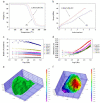Recent Trends and Developments in Conducting Polymer Nanocomposites for Multifunctional Applications
- PMID: 34502938
- PMCID: PMC8434364
- DOI: 10.3390/polym13172898
Recent Trends and Developments in Conducting Polymer Nanocomposites for Multifunctional Applications
Abstract
Electrically-conducting polymers (CPs) were first developed as a revolutionary class of organic compounds that possess optical and electrical properties comparable to that of metals as well as inorganic semiconductors and display the commendable properties correlated with traditional polymers, like the ease of manufacture along with resilience in processing. Polymer nanocomposites are designed and manufactured to ensure excellent promising properties for anti-static (electrically conducting), anti-corrosion, actuators, sensors, shape memory alloys, biomedical, flexible electronics, solar cells, fuel cells, supercapacitors, LEDs, and adhesive applications with desired-appealing and cost-effective, functional surface coatings. The distinctive properties of nanocomposite materials involve significantly improved mechanical characteristics, barrier-properties, weight-reduction, and increased, long-lasting performance in terms of heat, wear, and scratch-resistant. Constraint in availability of power due to continuous depletion in the reservoirs of fossil fuels has affected the performance and functioning of electronic and energy storage appliances. For such reasons, efforts to modify the performance of such appliances are under way through blending design engineering with organic electronics. Unlike conventional inorganic semiconductors, organic electronic materials are developed from conducting polymers (CPs), dyes and charge transfer complexes. However, the conductive polymers are perhaps more bio-compatible rather than conventional metals or semi-conductive materials. Such characteristics make it more fascinating for bio-engineering investigators to conduct research on polymers possessing antistatic properties for various applications. An extensive overview of different techniques of synthesis and the applications of polymer bio-nanocomposites in various fields of sensors, actuators, shape memory polymers, flexible electronics, optical limiting, electrical properties (batteries, solar cells, fuel cells, supercapacitors, LEDs), corrosion-protection and biomedical application are well-summarized from the findings all across the world in more than 150 references, exclusively from the past four years. This paper also presents recent advancements in composites of rare-earth oxides based on conducting polymer composites. Across a variety of biological and medical applications, the fact that numerous tissues were receptive to electric fields and stimuli made CPs more enticing.
Keywords: actuators; biomedical; conducting polymers; corrosion; doped; electronics; optical limiting; sensors; shape memory polymers.
Conflict of interest statement
The authors declare no conflict of interest.
Figures
















Similar articles
-
Revolutionizing Drug Delivery and Therapeutics: The Biomedical Applications of Conductive Polymers and Composites-Based Systems.Pharmaceutics. 2023 Apr 10;15(4):1204. doi: 10.3390/pharmaceutics15041204. Pharmaceutics. 2023. PMID: 37111689 Free PMC article. Review.
-
Electrically conducting polymers for bio-interfacing electronics: From neural and cardiac interfaces to bone and artificial tissue biomaterials.Biosens Bioelectron. 2020 Dec 15;170:112620. doi: 10.1016/j.bios.2020.112620. Epub 2020 Sep 19. Biosens Bioelectron. 2020. PMID: 33035903 Review.
-
Conducting polymers: a comprehensive review on recent advances in synthesis, properties and applications.RSC Adv. 2021 Feb 3;11(10):5659-5697. doi: 10.1039/d0ra07800j. eCollection 2021 Jan 28. RSC Adv. 2021. PMID: 35686160 Free PMC article. Review.
-
Conducting polymer-inorganic nanocomposite-based gas sensors: a review.Sci Technol Adv Mater. 2021 Jan 6;21(1):768-786. doi: 10.1080/14686996.2020.1820845. Sci Technol Adv Mater. 2021. PMID: 33488297 Free PMC article. Review.
-
Conductive polymer-based sensors for biomedical applications.Biosens Bioelectron. 2011 Jan 15;26(5):1825-32. doi: 10.1016/j.bios.2010.09.046. Epub 2010 Oct 1. Biosens Bioelectron. 2011. PMID: 21030240
Cited by
-
Head-to-Tail and Head-to-Head Molecular Chains of Poly(p-Anisidine): Combined Experimental and Theoretical Evaluation.Molecules. 2022 Sep 26;27(19):6326. doi: 10.3390/molecules27196326. Molecules. 2022. PMID: 36234863 Free PMC article.
-
Effect of Marble Dust on the Mechanical, Morphological, and Wear Performance of Basalt Fibre-Reinforced Epoxy Composites for Structural Applications.Polymers (Basel). 2022 Mar 24;14(7):1325. doi: 10.3390/polym14071325. Polymers (Basel). 2022. PMID: 35406199 Free PMC article.
-
New Hybrid Adsorbents Based on Polyaniline and Polypyrrole with Silicon Dioxide: Synthesis, Characterization, Kinetics, Equilibrium, and Thermodynamic Studies for the Removal of 2,4-Dichlorophenol.Polymers (Basel). 2023 Apr 25;15(9):2032. doi: 10.3390/polym15092032. Polymers (Basel). 2023. PMID: 37177179 Free PMC article.
-
Enhanced long-term corrosion resistance and self-healing of epoxy coating with HQ-Zn-PA nanocomposite.Sci Rep. 2025 Mar 9;15(1):8154. doi: 10.1038/s41598-025-92158-7. Sci Rep. 2025. PMID: 40059093 Free PMC article.
-
Synthesis and Characterization of Temperature- and pH-Responsive PIA-b-PNIPAM@Fe3O4 Nanocomposites.Nanomaterials (Basel). 2025 Jul 4;15(13):1041. doi: 10.3390/nano15131041. Nanomaterials (Basel). 2025. PMID: 40648746 Free PMC article.
References
-
- Walatka V.V., Labes Perlstein J.H. Polysulfur nitride—A one-dimensional chain with a metallic ground state. Phys. Rev. Lett. 1973;31:1139–1142. doi: 10.1103/PhysRevLett.31.1139. - DOI
-
- Cheng Q., Pavlinek V., Li C., Lengalova A., He Y., Sáha P. Synthesis and structural properties of polypyrrole/nano-Y2O3 conducting composite. Appl. Surf. Sci. 2006;253:1736–1740. doi: 10.1016/j.apsusc.2006.03.004. - DOI
-
- Wang X., Wang T., Liu D., Guo J., Liu P. Synthesis and electrochemical performance of CeO2/PPy nanocomposites: Interfacial effect. Ind. Eng. Chem. Res. 2016;55:866–874. doi: 10.1021/acs.iecr.5b03891. - DOI
-
- Kumar P.R., Venkateswarlu M., Satyanarayana N. Synthesis and ac conductivity studies of PEO+ LiClO4+ La2O3+ MoO3 nanocomposite polymer solid electrolyte. NSTI-Nanotech 2012. 2011;1:546–549.
-
- Zamborini F.P., Alphenaar B.W., Kharel P.L. Enhancing the Photovoltaic Performance of Dye-Sensitized Solar Cells with Rare-Earth Metal Oxide Nanoparticles. Meet. Abstr. 2017;15:879.
Publication types
LinkOut - more resources
Full Text Sources
Miscellaneous

